This page may contain compensated links. Please see our disclaimer at the end of this page for further info.
Taking a Family Gap Year is hands down one of the best things that you’ll ever do in your life.
In our experience, nothing compares with the freedom of taking a year off to travel with family, showing your kids the world and spending time together exploring our beautiful planet.
A gap year with family can be incredibly rewarding – but there’s also a LOT to think about and plan both before you set out, and while you’re on the road. Here you’ll find 10 useful things about how to take a family gap year, including some must-knows about travel for a year with family.
Contents
- 1 What is a gap year?
- 2 How Much Does A Family Gap Year Cost?
- 3 Taking A Gap Year – Where To Go?
- 4 Favourite Family Gap Year Destinations
- 5 Accommodation Options For A Family Gap Year
- 6 How To Get Around On A Family Gap Year
- 7 Essential Gear For A Family Gap Year
- 8 Working Or Volunteering During A Family Gap Year
- 9 What If The Worst Happens?
- 10 Kids On The Road – Schooling And Socialisation
What is a gap year?
Strictly speaking, there’s no clear-cut definition of a family gap year. For some families, it involves taking an unpaid sabbatical from work (if you have flexible employers!), taking the kids out of school if they’re old enough and traveling the world for a year.
For other people, it’s about making a complete break from life as they know it – either selling or renting their home or forfeiting a lease, quitting their jobs and just going with the flow.
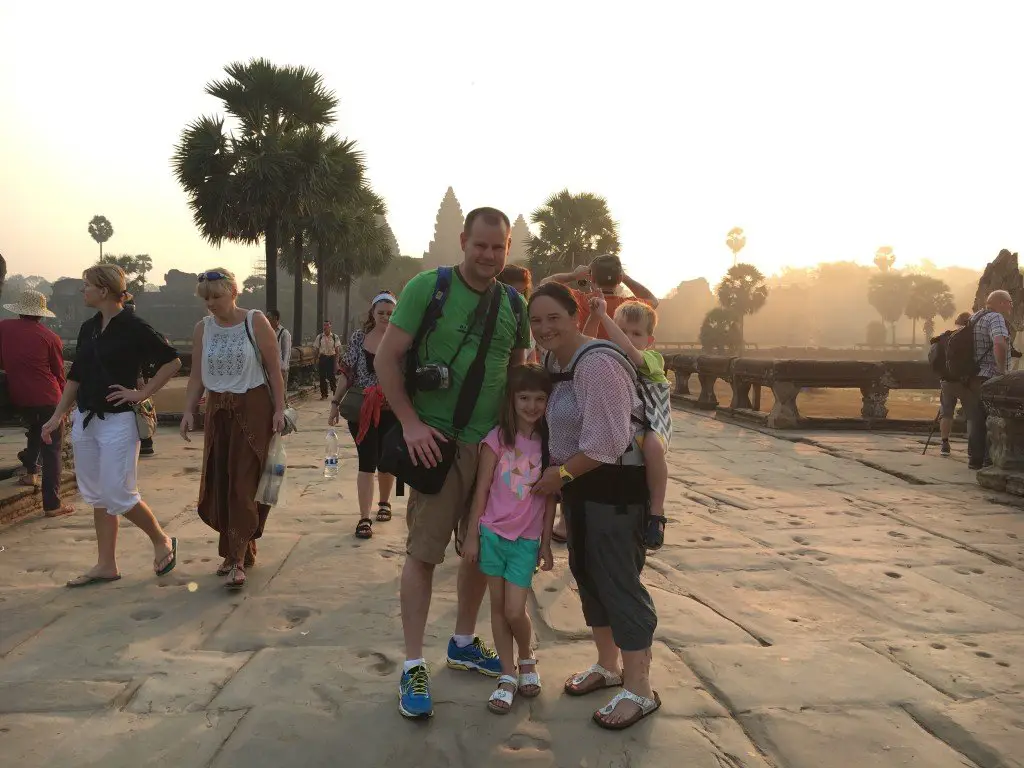
Us at Angkor Wat
There are also lots of people on a travel gap year who continue to work remotely or set up their own location independent businesses to become ‘digital nomads’. Some even travel during their maternity leave.
The length of time can vary too – while it’s known as a ‘gap year’ some people travel for a shorter period, while we know plenty of other families that travel who had started out for a year but kept going!
So the meaning of gap year is different things to different people, but basically involves taking an extended time out from work, school and life – being unlimited by the standard 2-4 week vacation.
How Much Does A Family Gap Year Cost?
The big question on everyone’s lips when considering world travel with family is ‘what’s the cost of a family gap year?’
You may well be surprised.
Of course, everyone has different ideas and standards about accommodation, food, transportation, so what’s ok for one family may be a step too far for other families.
The destinations you travel to and how many places you visit also have an impact on spending. The rule of thumb tends to be the slower you travel, the less money you’ll spend.
On our travels, we tend to stay at mid-range accommodation, visit attractions that aren’t crazily priced, eat at middle of the road restaurants with a lot of street food in Asia, and use a mix of public transport and car rental depending on the destination. We occasionally splurge on bucket-list and once in a lifetime activities like cruising in Halong Bay in Vietnam, and a safari in Sri Lanka.
We generally aren’t luxury travellers, but we don’t slum it in unclean accommodation or take risks with our health either!
On our family gap year for two adults and two kids aged 4 and 6 our average daily spend was around $100 US dollars per day (not including flights, travel insurance and car hire) for a trip through South East Asia, Europe and the Middle East.
Want to see our full daily costs broken down per country and how much it cost us in total for our gap year?
Then fill out your details here and we’ll drop it straight into your inbox!
Taking A Gap Year – Where To Go?
Literally the world is your oyster when it comes to a family gap year, but there are some things you’ll want to check out and take into consideration before booking tickets and accommodation. Some destinations that are great for adventure travel in your 20’s may not be so suitable to visit with kids in tow.
Some points to consider include:
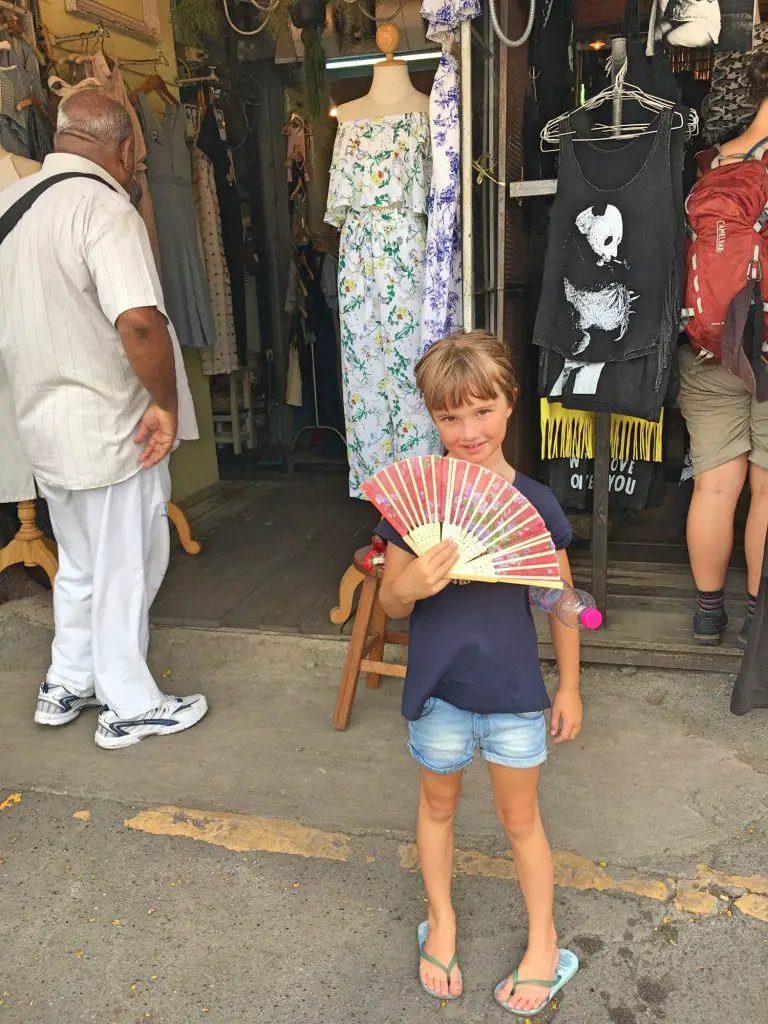
Soph trying to cool off at Chatachuk markets in Bangkok on a 38 degree day!
-Climate: there are some destinations that you may want to avoid when it is super hot (for example parts of India and the Middle East can reach almost 50 degrees in summer), super cold (parts of Northern Europe, Canada and Russia can reach minus 30 degrees Celcius in winter), or raining (much of Asia experiences monsoon rains at certain times of the year). So it pays to do your research and factor that in if you have your heart set on a particular destination.
-Altitude: unless you are from a high altitude environment already, you may want to think twice about taking your kids to places based at high altitude. The risk of altitude sickness in little ones is very real and can be life-threatening.
Unlike adults, they may not always show symptoms and be able to communicate when something is wrong. We had an incredible time in the Andes mountains in Argentina and Bolivia in our 30’s and although I would love to take the kids there, it just isn’t worth it until they are older in my opinion.
-Diseases: apart from the obvious things like avoiding areas with an Ebola outbreak (!), you need to consider diseases which may be a danger to small kids, particularly mosquito-borne diseases like the Zika virus, dengue fever, Japanese encephalitis and malaria.
It’s worth noting that in certain areas there is a lower risk of these diseases at certain times of the year, so it doesn’t necessarily mean that these destinations are on the no-go list.
For example, we’ve travelled to many places in South East Asia where these diseases exist but have been careful to take expert medical advice from our travel doctor, visit outside of the rainy season and made sure we take precautions such as using repellant and covering up at night and always carry malaria test kits and prophylactics in case of an emergency.
If you do choose to go to a malaria-prone area, please see expert medical advice on appropriate prophylactics to use as mosquito resistance can vary by country.
-Civil unrest and ‘no go’ areas: When planning your itinerary, it pays to check your local government’s Safe Travel advisories to see where they advise not to travel or exercise extreme caution.
It’s every individual’s choice whether they travel with their family to an area with risk, and sometimes this needs to be taken with a grain of salt – our worldview is that we still chose to visit London and Paris even though the terrorist threat was deemed high and there had been incidents in the past, as we feel you need to get on with life and not let the threat of terrorism stop you.
However, you do need to check the warning levels for travel insurance purposes as you may not be covered if your government deems a destination a no go or high-risk area. Similarly, if anything does happen and you have ignored these warnings, there’s no guarantee that your government consular staff will be able to help you.
Favourite Family Gap Year Destinations
After taking all of the above into account, here are some of the most popular family gap year destinations and ideas for a gap year:
South East Asia:
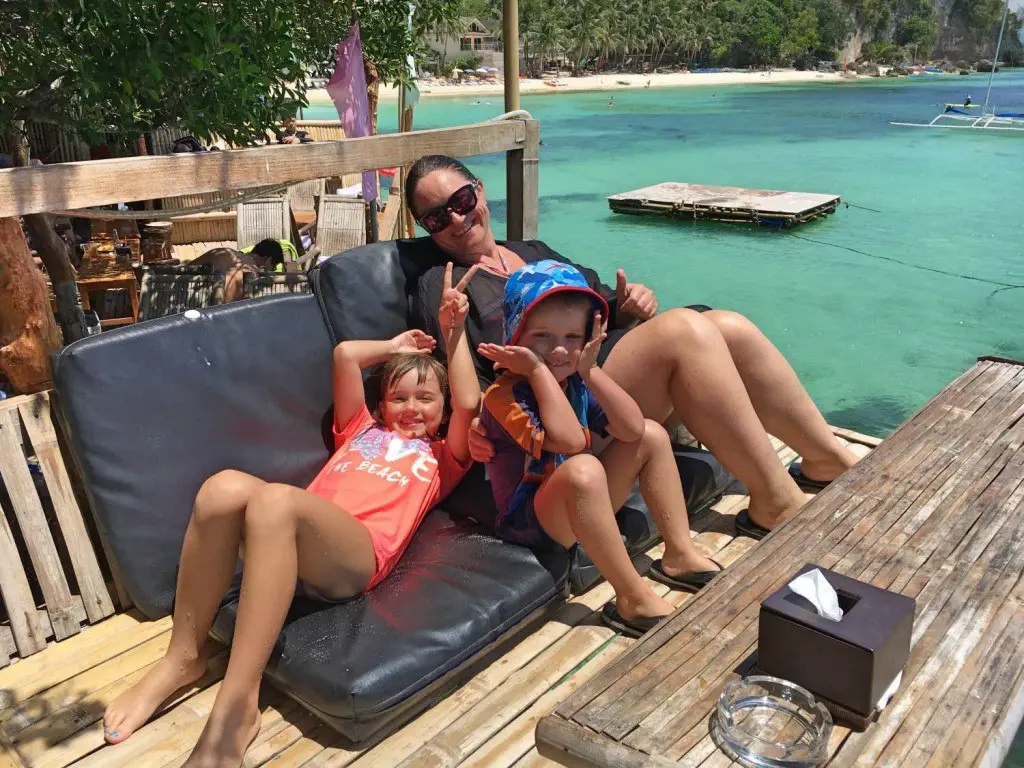
Chilling out in the beautiful Philippines
South East Asia is super popular for a family travellers gap year, and with good reason! Firstly it’s very kind to your wallet, with money stretching a long way.
The cost of accommodation provides much better value than in Europe, the USA or Oceania, and food is incredibly cheap and absolutely delicious.
South East Asia has some of the most diverse cultural experiences that the world has to offer. You can learn about ancient civilisations such as Angkor Wat in Cambodia, get great insights into different religions of the world and view some of the most beautiful and stunning architecture.
It’s also a wonderful place to hit the beach and chill out, with many islands and beaches offering pristine sandy beaches. The people are generally incredible friendly, kind and absolutely love kids. Our little travelling family got so much attention, kindness and help when we were in South East Asia, it was truly amazing.
If doing some family gap year volunteering is high on your wish list, then South East Asia offers ample opportunities.
It’s the perfect place for gap family adventures and our favourite destinations for travelling in gap year include Thailand, Malaysia, Cambodia, Vietnam and the Philippines.
Europe:
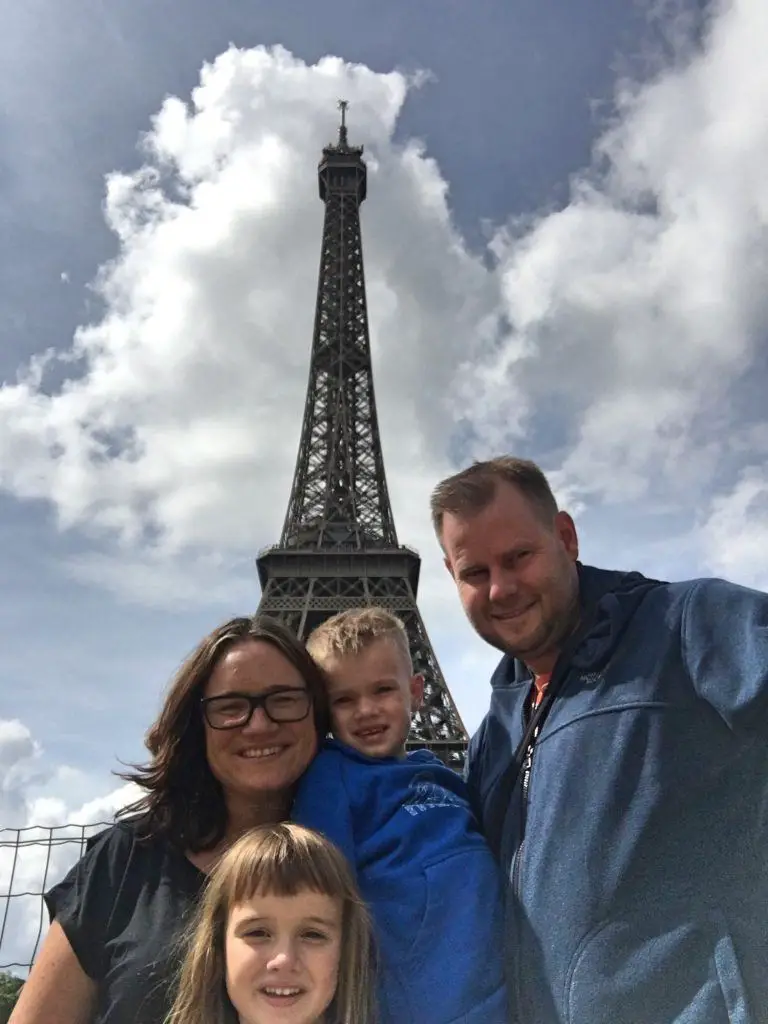
We love Paris!
We absolutely love travelling in Europe, and taking a family gap year in Europe guarantees something for everyone.
Apart from being a hub of world history, there are so many museums, lots of beautiful nature, fantastic food and experiences that make it great for a gap year with family.
It’s very easy to get around with excellent roading networks, fast and efficient trains and buses.
If you’re looking to travel the world with kids then Europe is a great one-stop-shop. There’s a good mix of budget destinations in Europe, as well as more expensive cities like Rome, London and Paris, so if you carefully manage your accommodation and spending options it’s certainly doable if you’re taking a gap year on a budget.
A family gap year itinerary for Europe takes some time to put together, simply because there is so much to see and do. Some of our favourite destinations to take your gap year kids include the UK, France, Italy, Finland, Croatia and Belgium.
Australia and New Zealand:
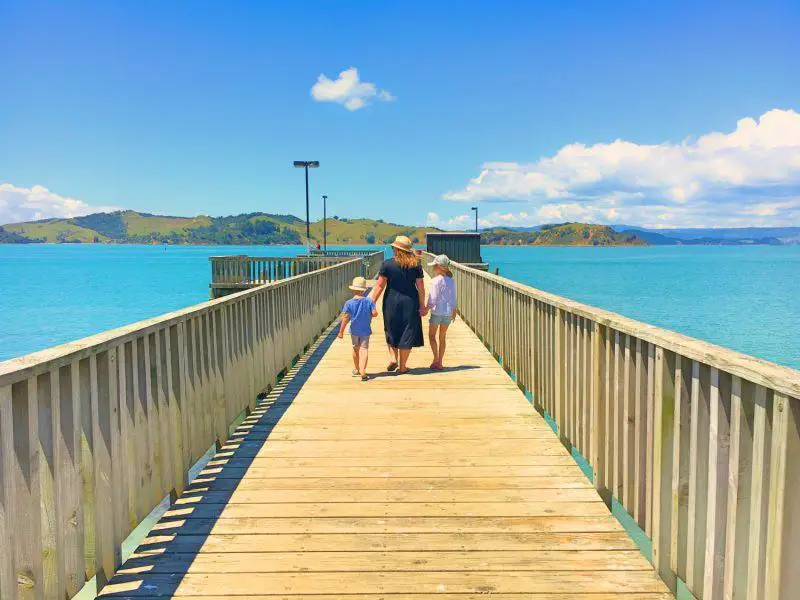
Gorgeous Waiheke Island in New Zealand
A family gap year Australia and New Zealand is high on many family bucketlists, particularly if you’re from the Northern Hemisphere.
We’re obviously biased coming from New Zealand (!) but there aren’t many countries on earth that have the diversity of landscape and breathtaking nature like New Zealand, all within such a small geographical space.
Australia, on the other hand, is huge, and an Australia gap year will challenge you because of the distances involved. However the rewards are fantastic, and you can get a great sense of achievement from touring Australia on your travel year.
Accommodation Options For A Family Gap Year
Once you’ve figured out your destinations, it’s time to start thinking about accommodation.
We like to have our accommodation, for the most part, figured out before we travel, as it often takes time to find the perfect place and doing the booking admin. We’d rather spend our time on the road doing and seeing things than worrying about finding somewhere to stay.
We also have found that good places tend to get booked out in advance, so if you are leaving it to the week (or even day before), you will have less choice. When you’re a couple travelling this isn’t so much of a big deal, but if you have 2 or more kids and are looking for family rooms, this will limit your accommodation options.
You also need to factor in peak travelling seasons as accommodation can be booked out months in advance. This includes Europe during Northern Hemisphere school holidays, Chinese New Year, Golden Week, TET and other festivals in Asia, and most late December to mid-January in Australia and New Zealand.
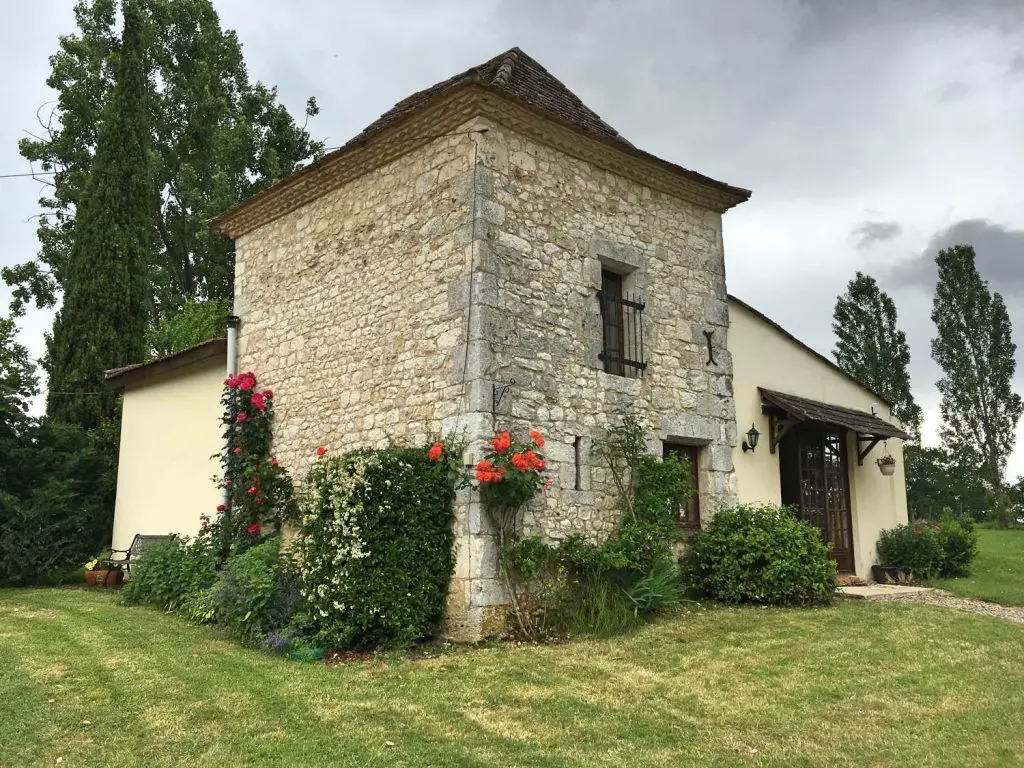
Le Pigeonnier – the house we rented in France for 3 months
We stayed for 3 weeks in Croatia in a seaside town in August, and pre-booked our accommodation around 10 months in advance to make sure we found somewhere to stay for a reasonable price.
However, the downside to this is you can’t be as flexible if you pre-book everything. Sometimes you may want to stay on a little longer if you find that perfect place, or cut short a destination if you’re not enjoying it. This isn’t always possible if you’ve pre-booked.
Types of accommodation
We tend to do a mix of hotels, Airbnb, homestays and even private rental when we’re booking accommodation. There are pros and cons to each of these, and here are some of the main considerations when choosing what style of accommodation to stay in.
Hotel accommodation
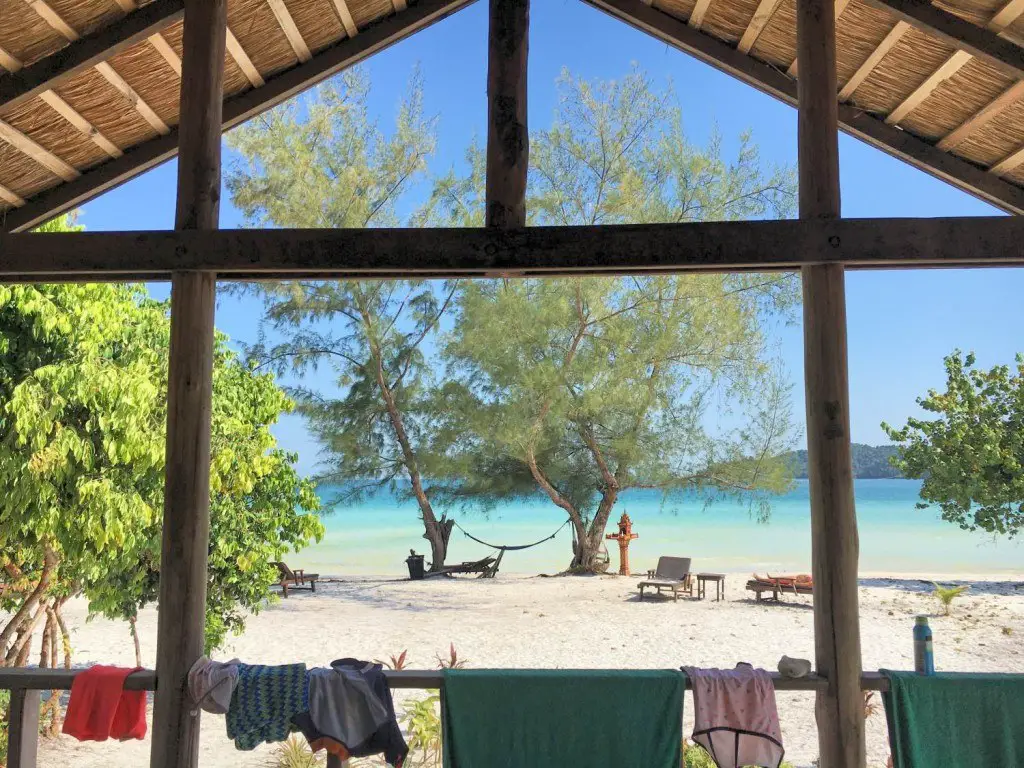
View from our bungalow hotel room at Secret Paradise Resort, Koh Rong Samloem island, Cambodia
Pros:
-Most hotels will have a reception, which is helpful for late arrivals, early departures and ease of access. Sometimes the meeting instructions for Airbnb rentals can be complicated and don’t work out of hours.
-In many cases there is a guarantee of what you are getting, particularly with chain hotels. For instance, we are big fans of the Accor hotel chain (think IBIS, Mercure), and no matter where you are in the world, you know that there will be a guaranteed standard.
-Breakfast and other meals may be included. We’ve found travelling with young kids that it’s great to be able to wake up and head to breakfast, which generally makes for a good start to the day. It can be a nightmare if you’re wandering around a foreign city trying to find something to eat for hangry kids!
-Most hotels are happy to store your bags for you if you’ve arrived early or have a late departure time. This isn’t always the case with Airbnb accommodation.
Cons:
-Hotels can sometimes be impersonal and sterile, and that can wear thin after you’ve been on the road for a while.
-Hotel locations are often in main tourist areas, so you don’t get the feel for ‘living like a local’ that you sometimes do when staying in Airbnb or private rental accommodation.
-Hotels can often be much more expensive for the equivalent of an Airbnb.
-Reliable WiFi can often be a problem in hotels in some countries. You either need to pay extra for it, or it is only available in communal areas such as the lobby, or it runs at a snail-like pace!
Tips for booking hotels
Our favourite website for booking hotels is Booking.com. We use this website for all hotels we book and have never had any issues with it.
There are no additional booking fees from using Booking.com
Another bonus is that many of the listings offer free cancellation right up until the day before travel. So if you change your mind or itinerary, it’s easy to cancel your accommodation. This also allows you to book in advance to select the best offerings, with the flexibility to cancel later if you find a better deal or decide not to stay.
Want to try Booking.com?
Click here to make a booking, and you’ll receive 10% off the cost of your stay! (disclaimer: I will also receive a $15 credit)
Homestays
Pros:
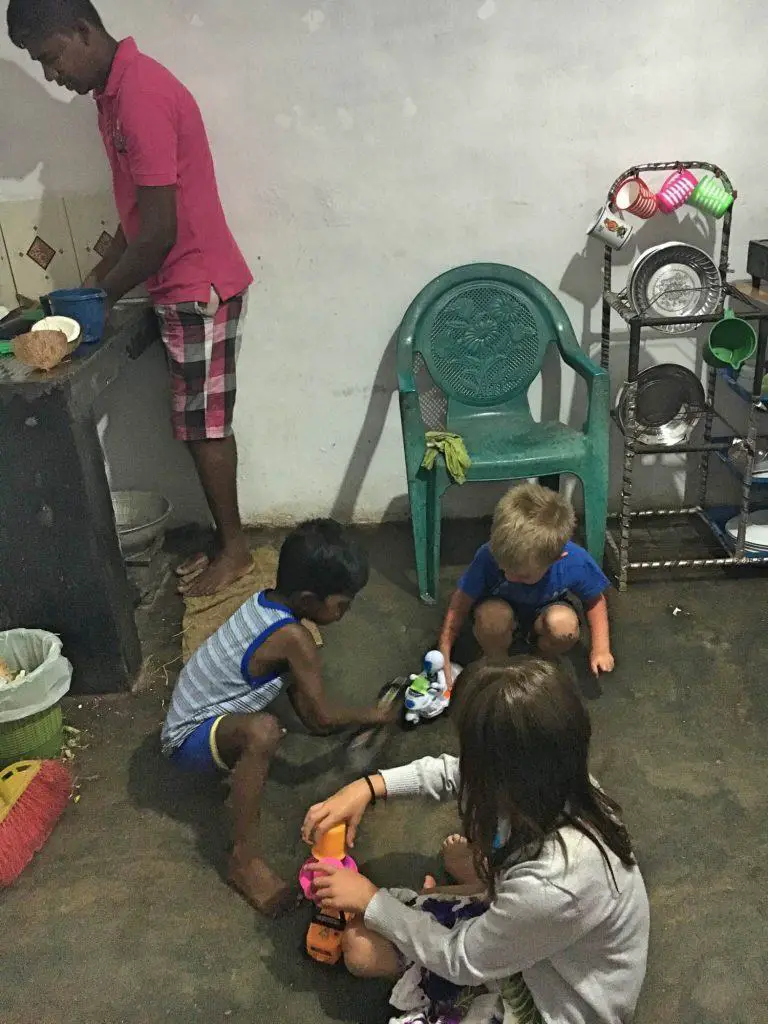
Making friends at our homestay in Sri Lanka
-Homestays are an amazing opportunity to live like a local. Generally speaking you get to stay in places that are a little bit off the beaten track.
-Often there will be extra activities available to you as part of the experience. For example when we stayed at a homestay in Ella, Sri Lanka, we got invited into our host family’s home where they prepared dinner with us and we ate the meal in their home. Nothing beats authentic experiences like this.
-You really help the local economy and people when booking homestays. The money goes directly to their pockets and helps them, rather than to big multi-national companies as is often the case with hotel chains.
Cons:
-Often the accommodation can be quite basic and no-frills.
AirBnB and private rentals
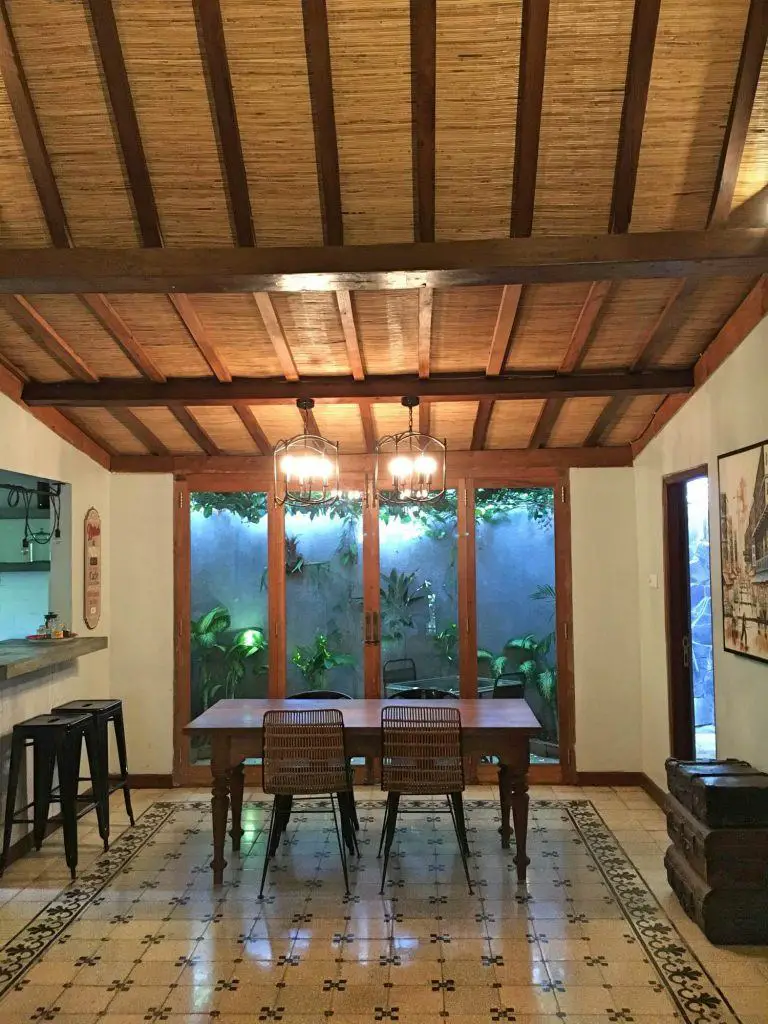
Our wonderful Air BnB home in Bali for a month
Pros:
-We’re huge AirBnB fans! The biggest plus for us is having a home away from home with a kitchen. Because our kids are still quite young and we have a loose routine, we find it handy to be able to cook the odd meal and do breakfasts – which also helps us save money!
-AirBnBs tend to be bigger than hotel rooms. We find being together 24/7 it’s good to be able to have a parent room and kids room, plus a living space rather than squishy hotel rooms all the time.
-AirBnBs can be significantly cheaper than hotel rooms. We’ve literally saved thousands of dollars by staying in Airbnb accommodation rather than hotels.
-Often you can generate significant long-stay discounts by staying for a couple of weeks or more, which is perfect for gap year family travel. For example we saved 40% off the price of our AirBnb in Bali because we booked for a month.
-AirBnb have excellent support behind them. If your chosen stay isn’t up to scratch or there are issues, they will either arrange for the problem to be fixed immediately, and/or organise a refund or find you alternate accommodation. We’ve heard nothing but good things about the support available if things go wrong.
-We’ve met some lovely people who have been our AirBnB hosts and often they will share with you their insider knowledge about the neighbourhood, great places to eat and things to see that you wouldn’t get through booking a hotel.
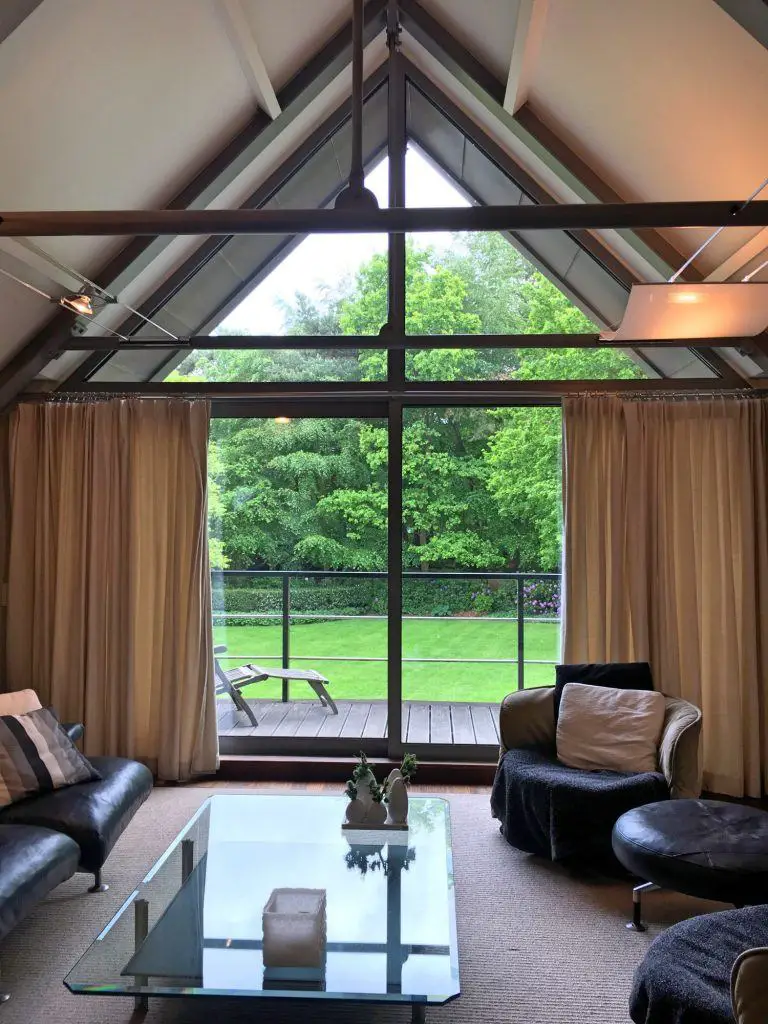
A fabulous house in Brugge, Belgium that we rented through Air BnB
Cons:
-It can sometimes be a bit vague when co-ordinating how to access the property, with complex instructions on keypad entry or meeting points, particularly if you’re arriving late at night. Rocking up to a hotel reception is definitely simpler, but we think the advantages outweigh this minor inconvenience.
-You don’t always know what you’re getting. Yes there are horror stories out there about the state of a place on arrival, but we’ve never had any issues.
However we always book properties that have at least 3 or 4 reviews, and try to pick Superhosts where we can to guarantee the quality of a property. If things do go wrong, you’ve got the backing of AirBnB excellent customer support.
Want to try AirBnB?
Would you like a $20 USD AirBNB credit? Click on this link when you’re booking and we both get a credit thanks to AirBNB
How To Get Around On A Family Gap Year
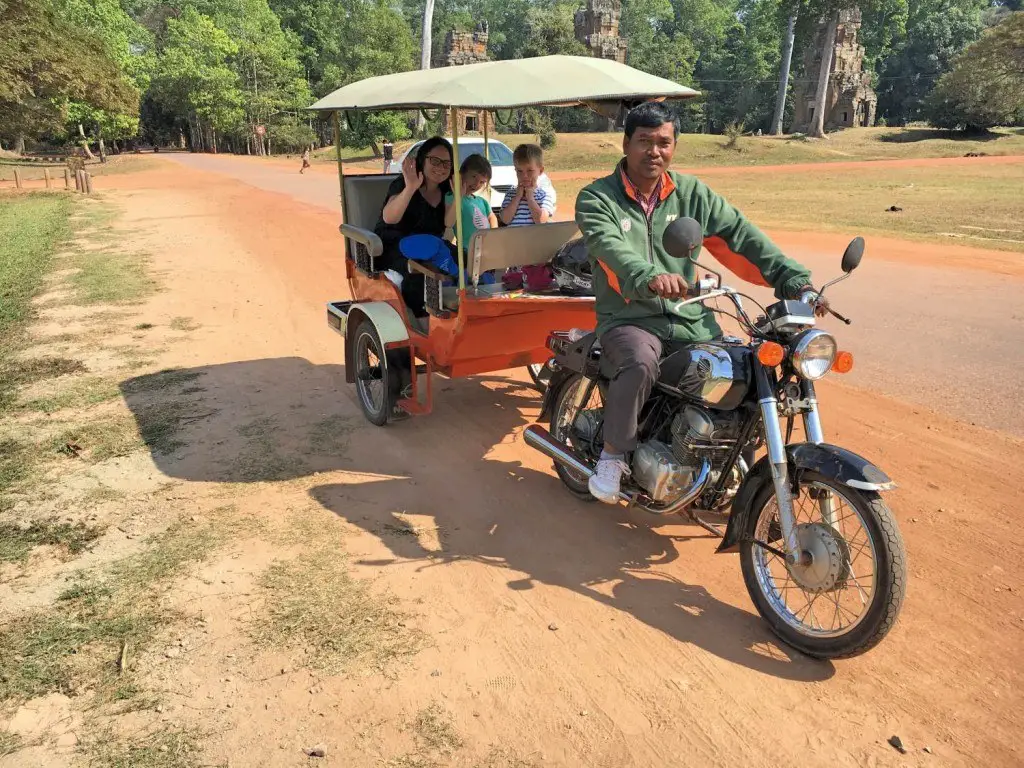
All aboard the tuktuk in Cambodia!
Planes, trains and automobiles – you’ll likely do all of these and more! Try adding rickshaws, tuktuks, bicycles, ferries, speedboats, bamboo rafts, kayaks and scooters to the list and that’s a realistic approximation of the different modes of transport you might come across during your year away.
Tip: We were repeatedly told not to bother bringing child car seats to Asia as the vehicles have no seatbelts. We did anyway and found that most of the cars we travelled in did indeed have seatbelts so we could strap the kids in safely. But when riding tuktuks? Forget about it!
Of course each country is different with its modes of transport, so you’ll need to research up on this. But here are some details for some of the bigger ticket items.
Airlines
The first decision you will need to make is whether to purchase a round-the-world ticket with one of the big airline groups such as Star Alliance or One World.
The advantages of this are that you know up-front what your flight costs will be, how many legs you are eligible to use and can plan from there.
However this can actually end up being a more expensive option that do-it-yourself bookings and utilising budget airlines.
In our experience, we always do the bookings ourselves, and mostly always when there are airline sales on. We’ve literally saved thousands travelling this way over the years. We also collect air miles with our different flights and sometimes use these to get a free flight, or subsidise them.
Some of the budget airlines are no-frills and you certainly get what you pay for. But in our opinion the savings are worth it, and we’d prefer to spend our savings once we reach the destination rather than on fancy flights. In over 100 flights we’ve never had any issues with cancelled flights, lost bags or safety issues (touch wood!)
Here are some of our favourite budget airlines that we’ve travelled with and recommend.
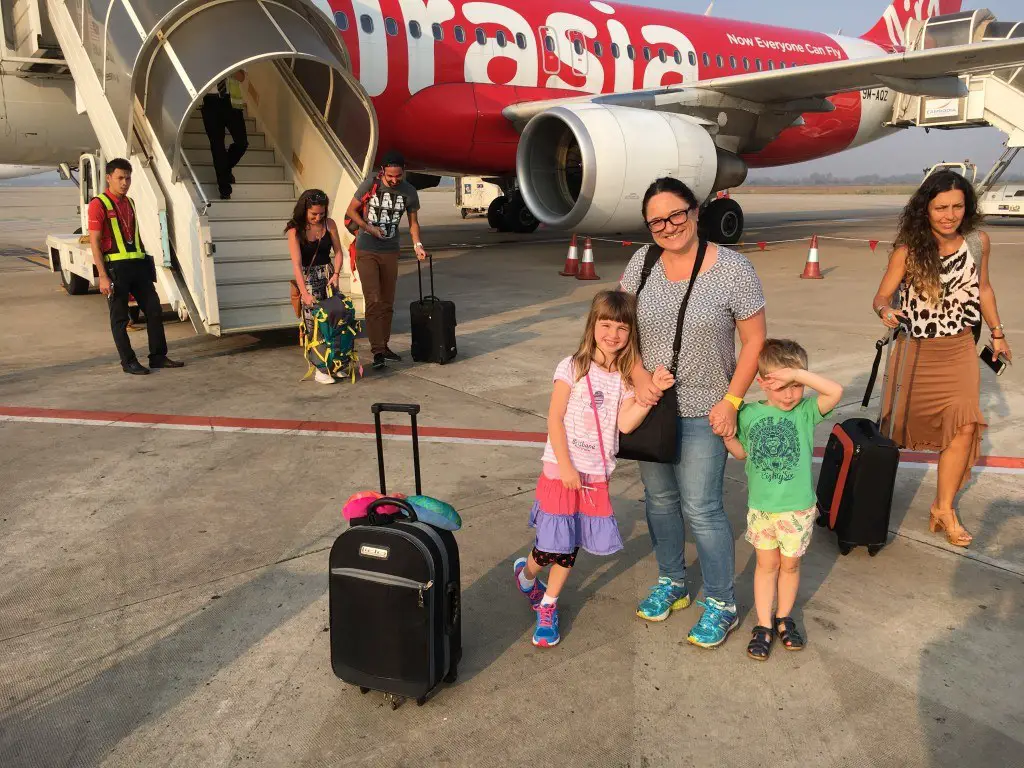
Air Asia flight to Siem Reap, Cambodia
Air Asia: We have flown over 20 times with Air Asia right across their network and agree that they’re the world’s number 1 budget airline.
Jetstar: We’ve taken both short hops within New Zealand and Australia and long-haul from Australia to Japan with Jetstar.
Scoot: These guys used to have a not so great reputation, but now they’ve been purchased by Singapore Airlines and have upped their game. We flew Athens to Melbourne via Singapore with them in mid-2018 and it was great. They do charge a lot for baggage however.
Cebu Pacific Air: Cebu Pacific Air is a Phillipines based airline that flies to over 60 destinations around Asia, Australia and the Middle East. Their fares are extremely good value and the staff are super friendly.
Norwegian Air: Norwegian are taking the US and Europe by storm with their low-cost fares, modern fleet and good service. We have flown long-haul from the US to Europe and short-haul within Europe and rate them highly. Just take your own food however as their meals on-board are extremely expensive!
Easyjet: We’ve been flying Easyjet for 18 years now and they’re a great budget airline choice within Europe and beyond.
Ryanair: Although they’re often in the headlines for the wrong reasons, Ryanair is still a good budget choice, if you can navigate your way around their confusing website and all the additional charges!
Other recommended budget airlines that we’ve heard positive things about include WOW Air (Icelandic owned and fly to the USA, Canada and Europe), WestJet (Canadian owned and fly in North America and UK), and Eurowings (German-owned and flying throughout Europe, US, Middle East and Africa!)
Buses, Trains and Ferries
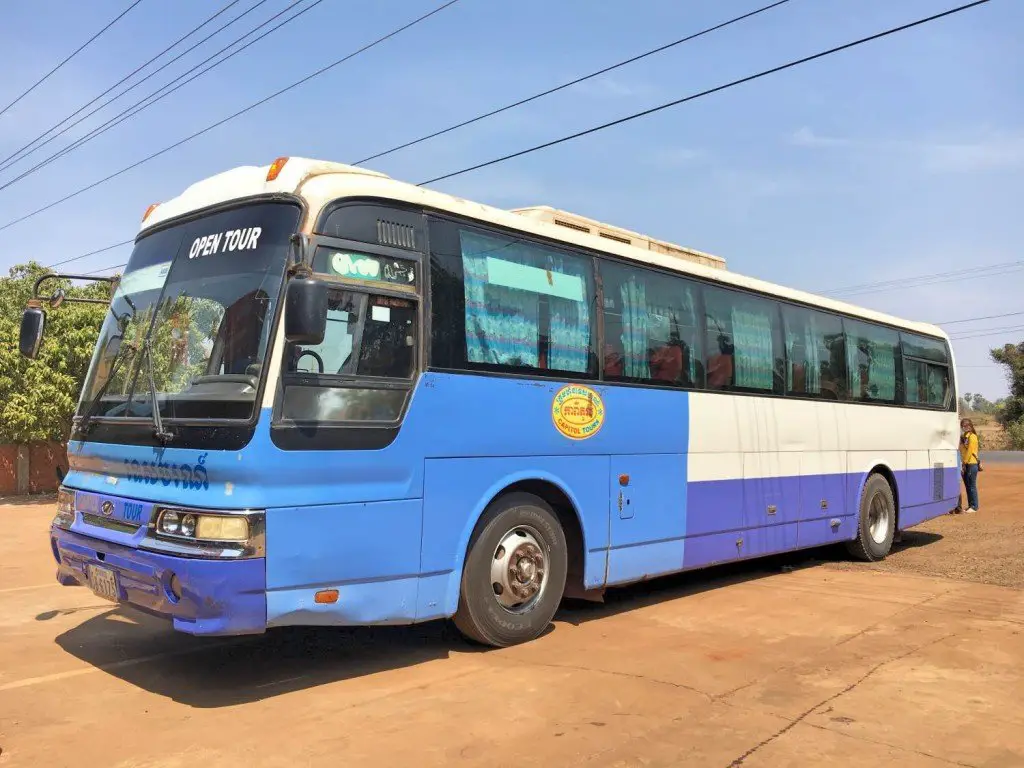
The Capitol Tours bus from Phnom Penh to Siem Reap
Buses and trains can be a great way to get around on your gap year, particularly in South East Asia, South America and Europe.

On the overnight sleeper train in Vietnam
Particular highlights we’ve experienced include taking local buses in Cambodia and the Philippines (a great way to meet locals and get a feel for their everyday lives!), an overnight train in Vietnam, excellent quality overnight sleeper buses in Argentina, a stunning train ride through tea plantations in Sri Lanka, riding super fast on the shinkansen bullet trains of Japan, and a scenic ride through the mountains and lakes from Slovenia to Munich.
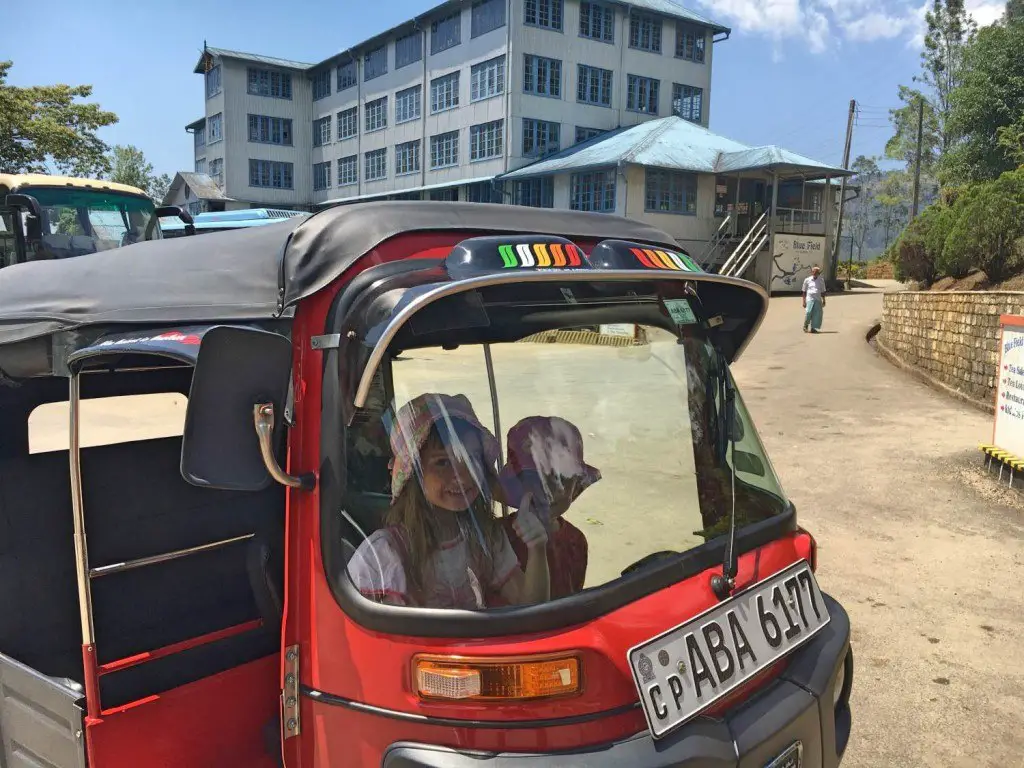
The kids in a tuk tuk in Sri Lanka
A great website to book your South East Asian ferries throughout Asia and New Zealand is the 12Go website. 12Go makes it so simple to book transport, without the fear of being ripped off or scammed! We highly recommend.
Car Rental
In many destinations, it’s a great idea to book a car. Nothing else gives you the freedom of being able to go when you want, when you want, particularly when you’re travelling with kids (think toilet stops at your leisure!)
It can often be cheaper to rent a car than pay for four or five bus or train tickets.
If you’re travelling longer-term in Europe and are not from an EU country, you may also want to consider a Eurolease. This is where you can rent a brand new Peugeot, Citroen or Renault car for up to six months, and the rates work out much cheaper than standard car rental.
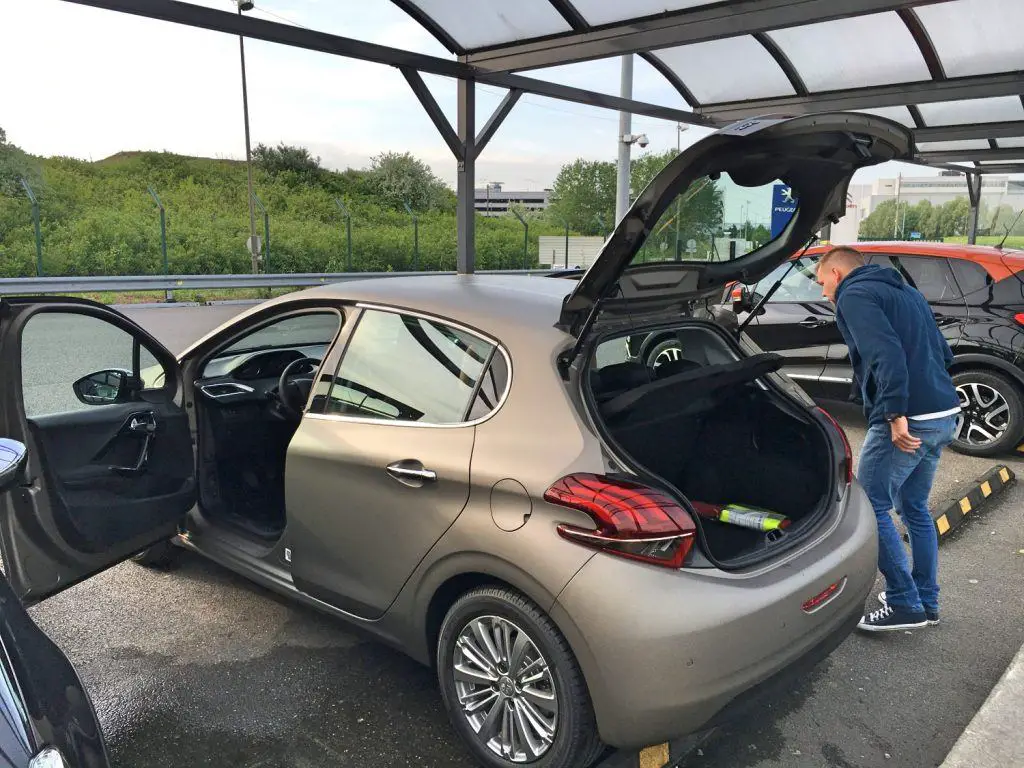
Picking up our Peugeot Eurolease that we hired for 4 months in Europe.
We have done Eurolease rentals four times in the past and loved it. It’s a very carefree way of travelling given that all insurance, registration costs are taken care of, and roadside assistance is all part of the deal.
You can find out more about Eurolease here:
Eurolease New Zealand, Eurolease Australia, Eurolease North America
Essential Gear For A Family Gap Year
Our biggest advice for packing for a family travelling around the world is PACK LIGHT!
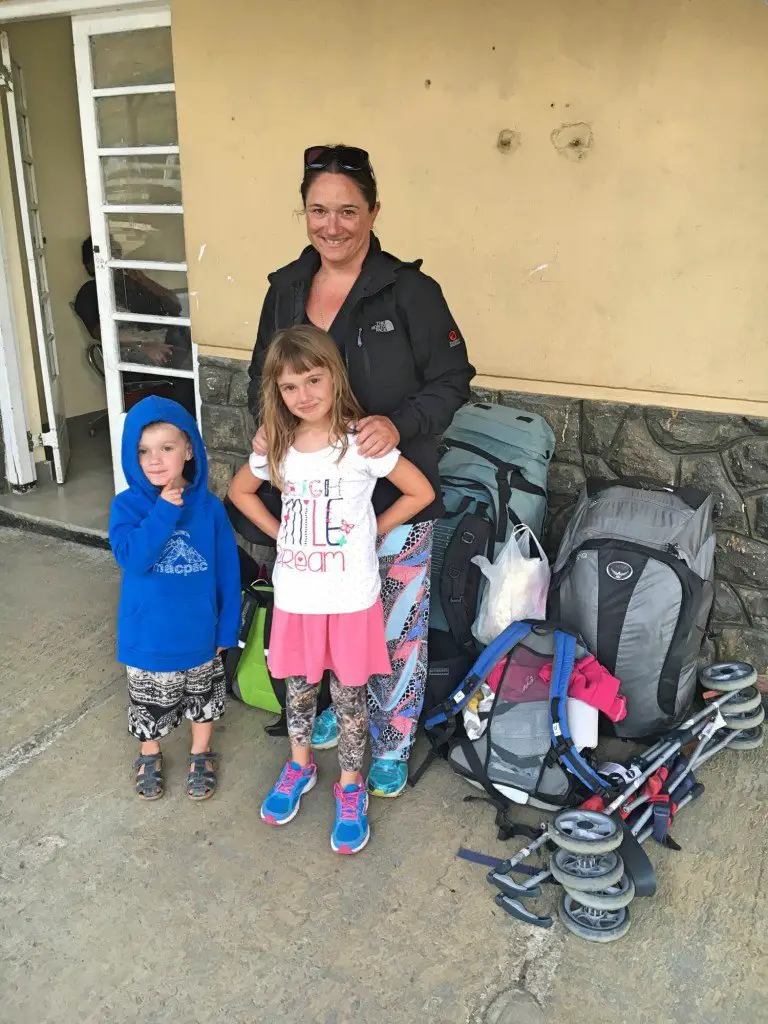
Waiting for the train with all our gear in Ella, Sri Lanka
Most people (including us!) find that they pack for every eventuality, but the reality is you need less than you think you do. Unless you’re going super intrepid and completely off-grid, in most places you will have access to clothing and footwear stores, and pharmacies.
You can read more about the gear and tools that we found essential when taking our family gap year here.
Working Or Volunteering During A Family Gap Year
If you’ve worked hard and saved for your gap year then you may not need to work while you’re travelling. Or maybe you have a house to rent out that will cover some or all of your expenses.
However, if you’re looking to top up your travel funds by working while your travelling, there are a number of ways to do this. Here are some ideas for family gap year jobs:
-Work remotely: the obvious first step is to see if you can take your current job on the road. If practical, then it’s worth a chat to your employer to see if there’s any way of continuing to do your job online or even project-based work online.
-Teaching a language: there’s always a need for native language speakers to teach others, and Skype or Facetime makes it super easy to do this on the road. If you’re a native English speaker with a college degree, then check out VIP Kid. By teaching Chinese students English online, you can earn between $14-22 USD per hour.
-Freelancing online: if you know your way around a computer, and even better have skills such as graphic design, social media management, writing, marketing, accounting, customer service or coding then there are plenty of freelance gigs going at Upwork.
-Work in exchange for accommodation: if physical labour is more your thing, or you’re experienced in the hospitality industry, then take a look at Workaway. Here you negotiate a set amount of hours of work in return for accommodation and food. While it’s mostly targetted at solo travellers and couples, there can be options that will accept families.
-Set up a travel blog: yes it’s possible to set up a travel blog and to make money from it via advertising, affiliate marketing sales, and creating products relating to your website. You can also save on your accommodation and activity costs if you get work with providers to get sponsored experiences. It can be very lucrative BUT it takes a long time to establish yourself and get to the point where your blog starts earning income – trust us, we do this for the love of it, not the money necessarily!
There are so many volunteering opportunities out there – both paid and free that you and your family can participate in. But it pays to do your research into ethically based opportunities. There’s growing evidence for example that volunteers in orphanages are actually detrimental – the children are subjected to forming close bonds with the volunteers, only to suffer abandonment and rejection again when they leave.
Animal-based volunteering also needs close examination to ensure that the organisation really does have the animals’ best interests at heart. This is particularly the case with elephants – any organisation that promotes the riding of elephants does not have the elephant’s welfare first and foremost.
Often some of the best and most ethical volunteering opportunities can be found word of mouth from other travellers. Check out the Facebook groups “Families On the Move” and “Families That Love Travel” for information. You could also take a look at some family gap year blog where people will write about their experiences.
What If The Worst Happens?
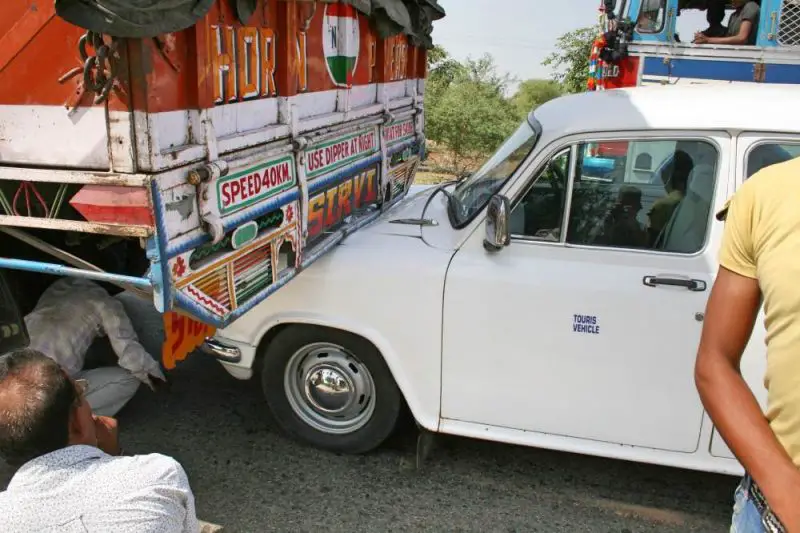
Crunch!
If there’s one item that you must have for your family gap year – it’s travel insurance.
The old saying is true “if you can’t afford travel insurance then you can’t afford to travel”.
Despite all the planning in the world, things can and do go wrong. (check out our blog post Travel Mistakes We’ve Made if you want some examples!)
There are lots of travel insurance products out there to choose from, however here are some top tips when choosing insurance for your family around the world trip:
Pre-existing conditions:
Boring as it may be, please be super careful about reading up on and disclosing pre-existing conditions – even minor ones – as they simply won’t be covered if you do not disclose them or pay additional premiums to cover them.
There have been lots of sad stories of people who thought they were covered but weren’t because of an undisclosed pre-existing medical condition.
Adventure activities:
Pay attention to exactly what activities are covered and those that aren’t. For example, you may need to pay an additional premium to be covered for activities deemed ‘adventurous’ such as skiing, snowboarding, scuba diving, zip lining, hiking to certain altitudes or taking part in competitive sport.
Also pay attention to certain conditions attached to an activity, for example, your insurance may not be valid if you have a scooter accident but were not wearing a helmet at the time.
Return air tickets:
Some insurance policies are not valid if a return ticket has not been purchased, so if you plan to buy tickets as you go when taking a gap year, then check if this affects your insurance cover or not.
Validity period:
We’d highly advise purchasing your travel insurance as soon as you begin to book air tickets, accommodation and activities.
You never know what is around the corner, and if you haven’t purchased travel insurance and need to change your plans or cancel, then you won’t be covered.
Mother Nature can also be highly unpredictable and throw a curve ball into your plans. If natural disasters such as earthquakes, volcanoes, hurricanes or typhoons happen prior to your trip and your chosen destination is no longer safe to visit, you’ll only get re-embursed if you purchased travel insurance PRIOR to this event happening.
A good example of this is the ongoing volcano situation in Bali – since 2017 Mt Agung has been erupting intermittently, so travel insurance companies are only covering those people that have travel insurance purchased before the initial eruption. This means that even if you have purchased travel insurance since the eruption, you still won’t be covered for any volcanic activity disruptions.
We recommend World Nomads Travel Insurance. You can buy and claim online, even after you’ve left home. Travel insurance from WorldNomads.com is available to people from 140 countries. It’s designed for adventurous travellers with cover for overseas medical, evacuation, baggage and a range of adventure sports and activities.
Get a quick quote here!
Kids On The Road – Schooling And Socialisation
One of the biggest worries that families traveling the world have (including us!) is what to do about socialisation and schooling for their kids.
Socialisation
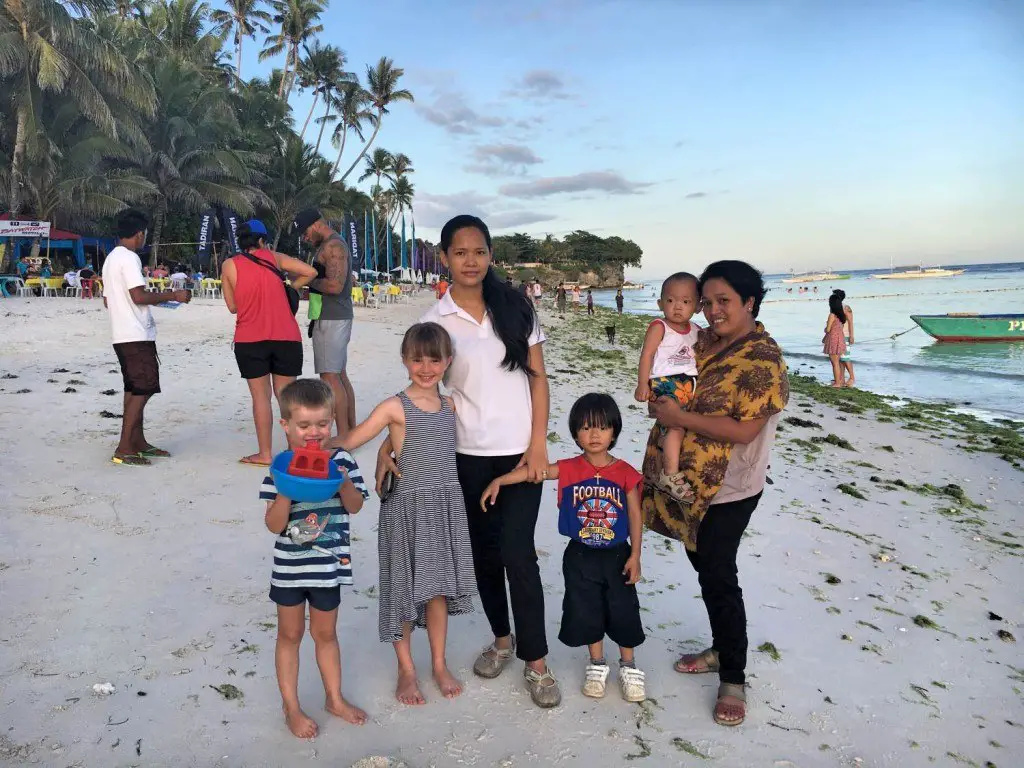
Making friends in the Philippines
Well for the socialisation aspect, we needn’t have worried!
Our kids easily made friends on the road with both locals and with other travelling families that we met up with along the way. They also managed to stay in touch with friends and family back home through Skype and Facetime.
You will be amazed how quickly your kids adapt to life on the road, and how readily they embrace meeting new friends – even the most shy kids. When meeting other travelling families, the shared experience gives them plenty to talk about.
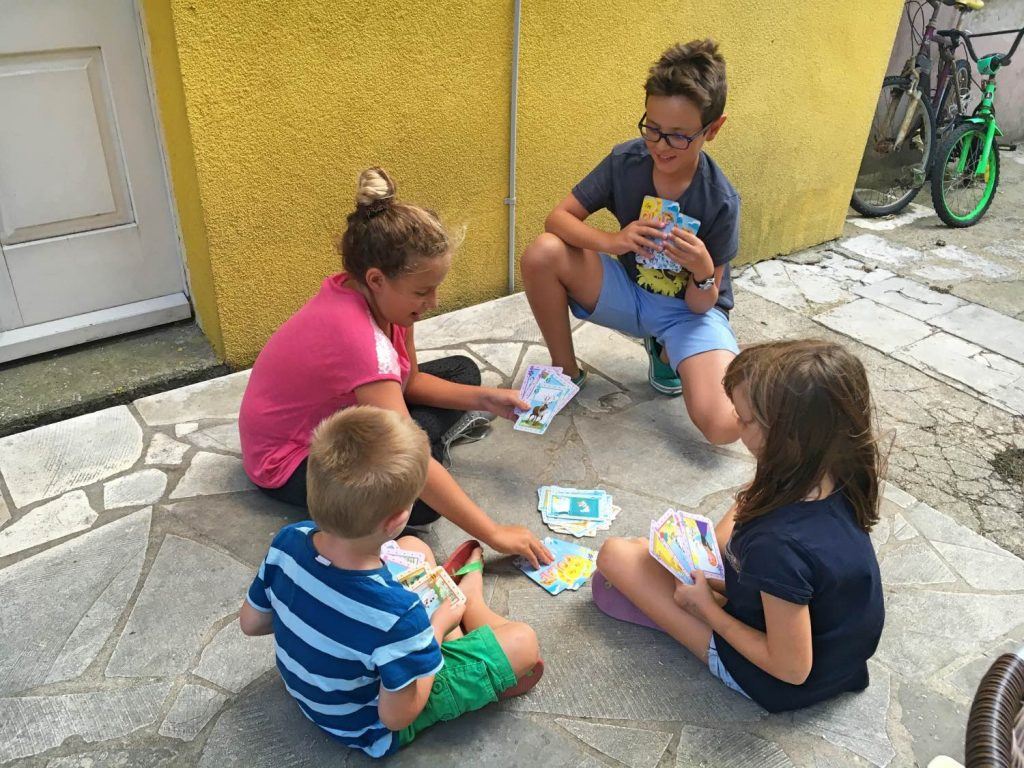
Playing cards in Croatia
Language need not be a barrier either. In Croatia our kids happily played cards with our next door neighbours even though they couldn’t really talk to one another. In the Philippines, our kids had a fun night playing at the beach with some local kids one evening.
Schooling
When taking longer-term world travel with kids, schooling is a big one. Broadly speaking, the approach to family gap year school tends to fall into three categories or a combination of these:
Homeschooling:
This is where you try to keep up some form of formal schooling as you travel and/or follow a set curriculum.
This can be following an online curriculum such as BookShark, paper based workbooks, or a distance education programme from your home country.
There are also so many apps and websites out there to assist with learning. Some of our favourites include:
–Khan Academy – free online learning tools
–Reading Eggs – our kids LOVE this literacy website
-Mathletics – online maths education tool
-How Stuff Works – science and general knowledge website
–Twinkl – teacher created planning and assessment materials and teaching resources
Worldschooling:
Less formal than homeschooling, worldschooling uses the children’s travels as the basis for their curriculum – all other learning takes place via the activities and localities they come across in their travels.
This could include visiting museums, taking part in a cooking class, opportunities to learn about nature, snorkelling in the ocean, taking part in a beach clean-up to learn more about sustainability, learning a foreign language while being in that country.
You can read more about worldschooling here and there is an excellent Facebook group that you can join with close to 50,000 members if you want to learn more about this phenomenon!
Unschooling:
Unschooling is also known as child-led learning. This is where children do not follow any formal curriculum, but focus their learning and efforts on what their own interests are and through natural life experiences.
The emphasis with unschooling is not necessarily what to learn, but on how to learn so that a lifelong love of learning is developed.
You can learn more about unschooling here.
During our gap year travels, we had a mixed bag of homeschooling and world schooling.
We tried to keep up with literacy and maths, got our eldest child to keep a journal of all the places they had visited and the rest was worldschooling. Some of the great worldschooling experiences they had included:
-releasing baby turtles back to the ocean from a turtle sanctuary in Bali
-learning to make spring rolls aboard a boat in Vietnam
-going on a safari to see elephants, buffalo, leopard, deer and birdlife in Sri Lanka
-visiting the Musee d’Orsay in Paris then learning about some of the famous paintings at school in France
– copious amounts of science museums!
-sending them to the market with a small amount of money and getting them to purchase the fruit and vegetables
-visiting a number of mosques, Buddhist temples, cathedrals, churches, Hindu temples and sacred shrines
Another tip, while schooling on the road is to look out for local schools or education facilities that run day classes or that take casual enrolments.
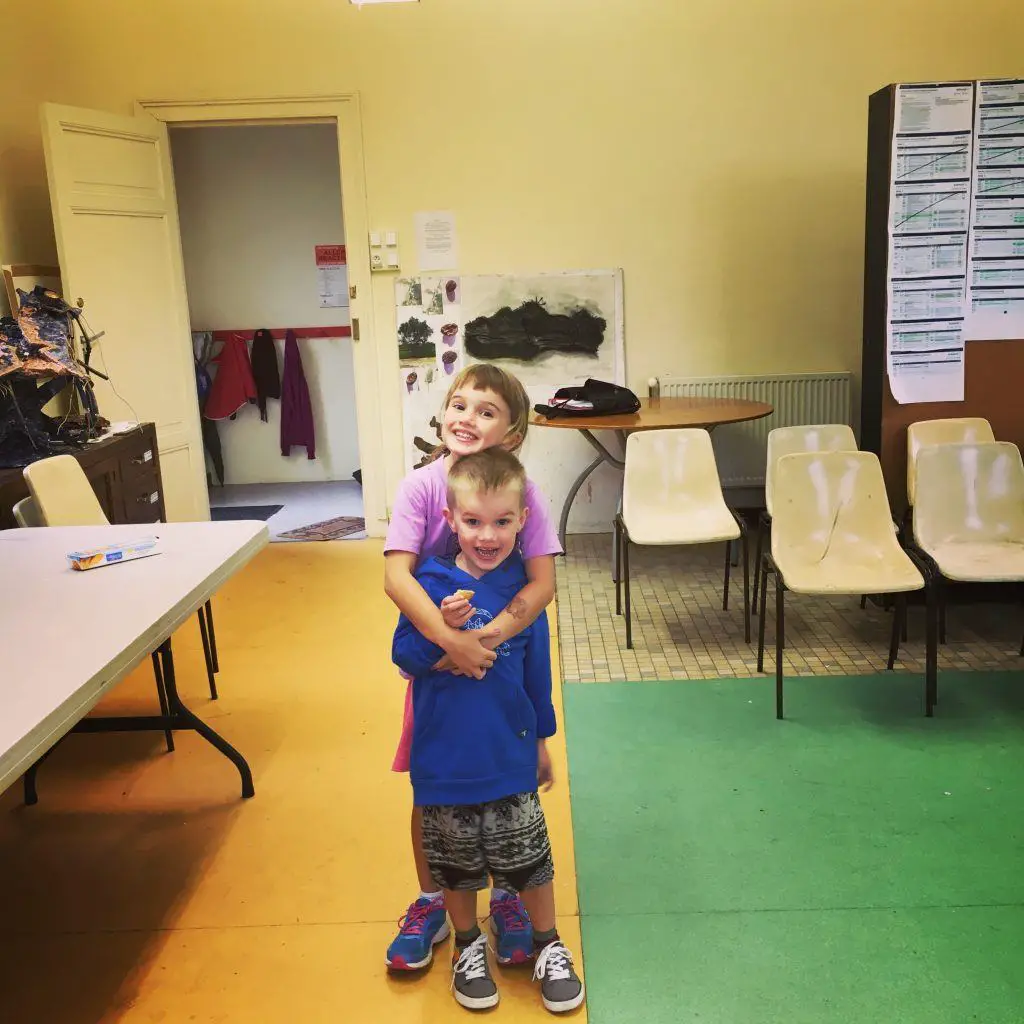
At school in France
While in France our kids attended ‘Wordy Wednesdays’ – a local programme for ex-pat English students enrolled in French school, to keep up their English literacy levels. Our daughter also attended drama and art classes.
The verdict
If you’re on the fence about whether or not to take a family gap year, our advice is to absolutely go for it.
Our gap year was two years ago, and our kids were only 3 and 5 years old when we left. But we still talk about it almost every day, and I’m constantly amazed at how much the kids remember from those travels.
The destinations you’ll visit will be incredible, and you’ll learn so much about yourself, your kids and the world.
But the best part of all? You’ll be doing it together, as a family. The experience of being together, learning and exploring without the burden of routine and all the other things that can get in the way of life is absolutely priceless.
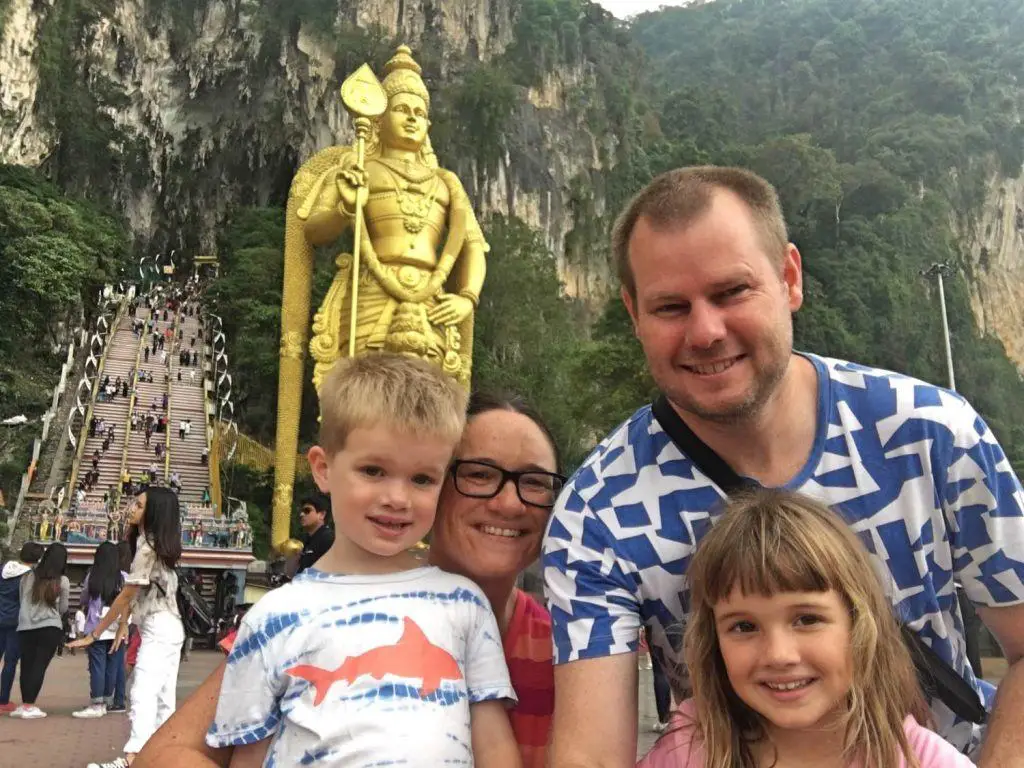
At the Batu Caves in Malaysia



Thank you for this content, it’s wonderful! I would love to see the breakdown of costs and the overall total for your Gap year.
Apologies Rachel, I’ve only just seen your comment. You can find a breakdown of costs here – https://ouroverseasadventures.lpages.co/family-gap-year-costs